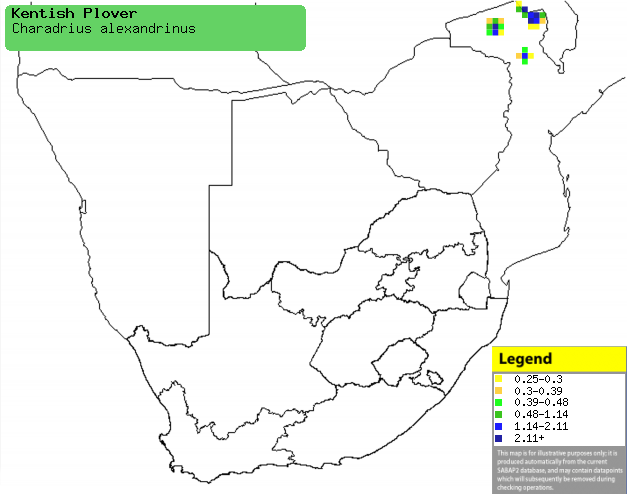|
Charadrius alexandrinus
(Kentish plover)
Kentse strandkiewiet [Afrikaans]; Strandplevier [Dutch];
Pluvier ŕ collier interrompu [French]; Seeregenpfeifer [German];
Borrelho-de-coleira-interrompida [Portuguese]
Life
> Eukaryotes >
Opisthokonta
> Metazoa (animals) >
Bilateria >
Deuterostomia > Chordata >
Craniata > Vertebrata (vertebrates) > Gnathostomata (jawed
vertebrates) > Teleostomi (teleost fish) > Osteichthyes (bony fish) > Class:
Sarcopterygii (lobe-finned
fish) > Stegocephalia (terrestrial
vertebrates) > Tetrapoda
(four-legged vertebrates) > Reptiliomorpha > Amniota >
Reptilia (reptiles) >
Romeriida > Diapsida > Archosauromorpha > Archosauria >
Dinosauria
(dinosaurs) > Saurischia > Theropoda (bipedal predatory dinosaurs) >
Coelurosauria > Maniraptora > Aves
(birds) >
Order: Charadriiformes > Family: Charadriidae
> Genus: Charadrius
Distribution and habitat
Breeds across much of Eurasia and North America between
5-55° North, heading south in the non-breeding season to the South America,
southern Asia and Africa, mainly in the Sahel desert from Senegal to Eritrea,
Ethiopia and Somalia. It is a vagrant to southern Africa, with the majority of
records in northern Mozambique, while rarely sighted along the coast of northern
Namibia, with one record at the coast of eastern Western Cape. It generally
prefers flat, open coastal habitats, especially sandy beaches and tidal
mudflats, while further inland it favours saline pans and wetlands with
extensive muddy margins.
|
 |
|
Distribution of Kentish plover in southern Africa,
based on statistical smoothing of the records from first SA Bird Atlas
Project (©
Animal Demography unit, University of
Cape Town; smoothing by Birgit Erni and Francesca Little). Colours range
from dark blue (most common) through to yellow (least common). |
Food
It mainly eats invertebrates, doing most of its foraging by
repeatedly running and stopping, plucking small prey from the ground or
trembling its feet to attract small animals to the water surface.
References
-
Hockey PAR, Dean WRJ and Ryan PG 2005. Roberts
- Birds of southern Africa, VIIth ed. The Trustees of the John Voelcker
Bird Book Fund, Cape Town.
|
